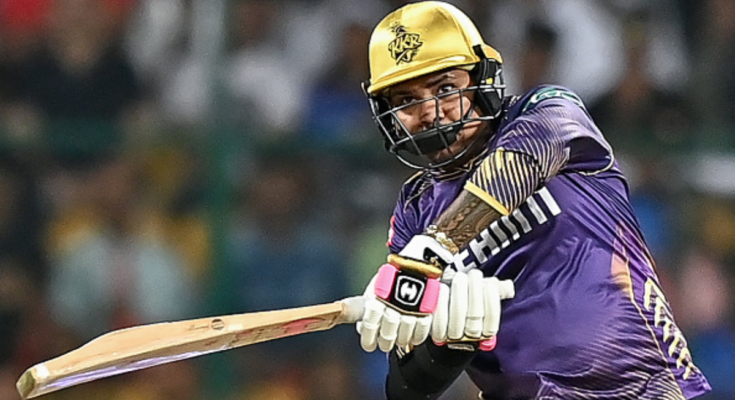Sunil Narine is back as an IPL opener and while it might not always work, when he gets going, he will provide KKR with a strong advantage, writes Sarah Waris.
There were plenty of talking points in Sunil Narine’s 500th T20 appearance, against RCB. He was expensive with the ball but his wicket of Glenn Maxwell brought KKR back in the game. He had spilled a catch earlier, but the night ended on a high for him after he smashed 47 in 22 balls, winning him the Player of the Match award.
A lethal spinner, Narine’s career took a new turn in 2017 after then KKR skipper Gautam Gambhir pushed him to open the innings. Narine had opened for the first time in a BBL clash earlier that year for Melbourne Renegades against Melbourne Stars, scoring 21 in 13 balls. Though Narine failed to get going in the two other games he opened, an impressed Gambhir backed him to do the job in the IPL.
As is common with the role of a bowler promoted to go after the bowler in the powerplay, Narine was more hit-and-miss in 26 innings while opening for the side in the next two seasons: He crossed 30 eight times but his role was not to score big runs but to make them quickly, which he excelled in.
Narine had a strike rate of 188 across 2017 and 2018 while opening, forming a fiery opening partnership with Chris Lynn. In the next two years, KKR struck at 158 in the powerplay, the only side to score above 150 in the period, largely due to their efforts.
The key to KKR’s success was how the openers complemented each other. Narine was skilful against spin, while Lynn was elite against pace. However, Lynn’s declining returns in 2019 saw him being released as Shubman Gill replaced him at the top. Also stronger against spin than pace, Gill’s presence opened an easy line of attack against KKR’s opening pair, which often meant the opposition started with quick bowlers against the duo in the powerplay. Narine was also soon found out against the short ball and failed to replicate his initial success.
The last time he crossed 15 while opening in the IPL before his knock against RCB was five years ago. Narine opened only seven times since the start of 2020 in the IPL until this season, failing to score thrice and getting to double digits only once. He continued to open in different T20 leagues, but seldom got big scores. He did not cross 40 while batting at the top in any T20 game and, by conventional definitions, the days of Narine the T20 opener seemed to be over.
Thus, it was a surprise when KKR opened with Narine in their first game of the 2024 IPL. He was run out for two against SRH but repaid the faith against RCB, which won him the Player of the Match award as he helped KKR chase down 183 comfortably. All but two of his deliveries faced, and all of his runs came inside the powerplay. By the time the field went back, he had done his job.
An out-of-the-box tactic, it is a move that KKR should persist with for two main reasons. Narine batted mostly in the lower middle order last year but did not find much success, scoring at a strike rate of 84 in 10 innings. Since he is not a great runner between the wickets, the runs dried up when the field was spread. It also meant he would be batting in the death overs more often than not when the best quicks would be operating.
And so, while he provided KKR with an illusion of batting depth, he was also playing in a position where they could not benefit from Narine the batter.
Pushing him up the order enabled KKR to maximise his batting prowess, giving him the freedom to play his shots up front.
Venkatesh Iyer, usually an opener in the IPL, has slotted at No.3 in KKR’s last two games. He has also batted down the order, in the middle overs, and is already accustomed to batting in different positions. If Narine is dismissed early, he can easily face the quicks. If Narine goes big, Venkatesh has the game to carry on against the spinners.
KKR have also brought in Phil Salt as an opener, a move that allows them to replicate the strategy they adopted six years ago with Lynn and Narine. Salt, like Lynn, is exceptional against the quicks, striking at 155 against them in all T20s. His strike rate drops to 144 against spin, which is where Narine is effective: his strike rate of 155 against the slower bowlers rises to 174 in the powerplay.
At the Chinnaswamy, on a track where the off-pace deliveries were troubling the batters, RCB sent down only 24 perfect slower balls compared to KKR’s 50 percent. Venkatesh, who made a fifty, expressed how the pitch was two-paced after the game, but RCB were conspicuous in holding back their spinners and not bowling slower balls up front. They introduced spin only in the seventh over, by when the match had slipped away. While the move was puzzling, Narine’s presence and strength against anything slow bowled at him played a part.
Faf du Plessis later admitted the contrasting strengths of KKR’s openers pushed them onto the back foot: “With Narine there, you can’t go to spin, you want to use pace upfront. That’s also a really good match-up for Salt and the way he plays.” The pace-on hardly troubled the KKR openers, who made 85 in the first six overs, half of which came off Narine’s bat.
While the RCB bowlers erred, they also seemed over-anxious to target Narine with short balls inside the powerplay, him Narine to get accustomed to them. Three of the five sixes by Narine came off the short balls and RCB never recovered.
At the other end, Salt kept up with the scoring speed, making 28 in 16 with two sixes in the powerplay as the contrasting strengths of the two batters worked in their favour.
KKR cannot expect Narine to come off every time, and teams will refine their strategies after seeing how RCB’s short-ball ploy floundered. But even if he fails more than he succeeds, KKR now have a ploy that can mess up the opponent’s game plan, and should exploit it to their advantage.
Subscribe to the Wisden Cricket YouTube channel for post-match analysis, player interviews, and much more.



